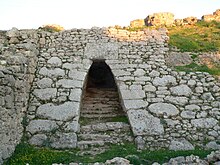 A postern gate of the Royal Palace of Ugarit | |
| Location | Ugarit, northwestern Syria |
|---|---|
| Coordinates | 35°36′06″N 35°46′59″E / 35.601719°N 35.783008°E |
| Type | Royal residence |
| Part of | Acropolis of Ugarit |
| Length | 110 metres (360 ft) |
| Width | 75 metres (246 ft) |
| Area | 6,500 square metres (70,000 sq ft) |
| History | |
| Material | Ashlar stone, wooden crossbeams, plaster |
| Founded | c. 15th – c. 13th-century BC |
| Abandoned | c. 1180 BC |
| Periods | Bronze Age |
| Cultures | Canaanite |
| Associated with | Niqmaddu II, Niqmepa, Ibiranu, Ammurapi, Ahatmilku |
| Site notes | |
| Excavation dates | 1929–1939 1948–1955 |
| Archaeologists | Claude F. A. Schaeffer |
| Condition | Partial restoration |
| Public access | yes |
The Royal Palace of Ugarit was the royal residence of the rulers of the ancient kingdom of Ugarit on the Mediterranean coast of Syria. The palace was excavated with the rest of the city from the 1930s by French archaeologist Claude F. A. Schaeffer and is considered one of the most important finds made at Ugarit.